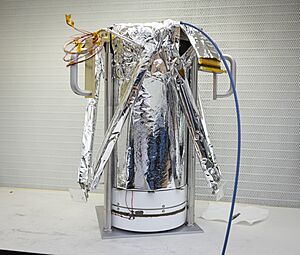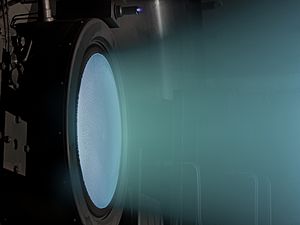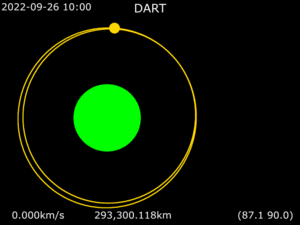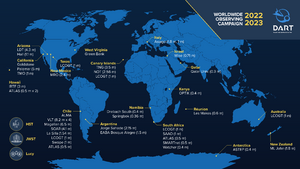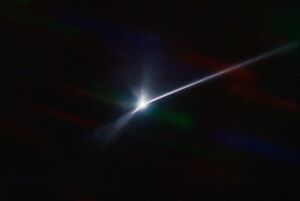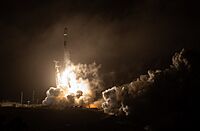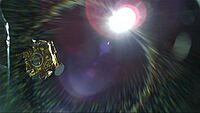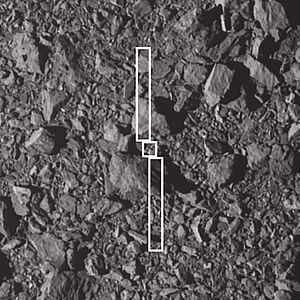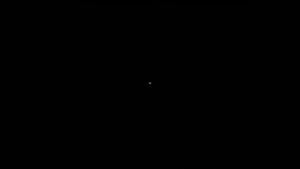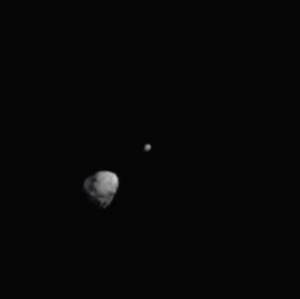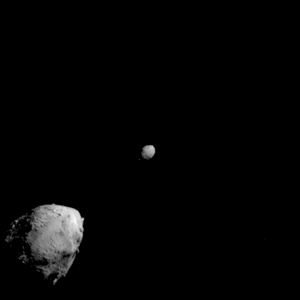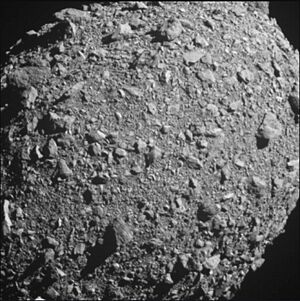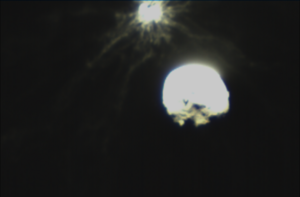Double Asteroid Redirection Test facts for kids

Diagram of the DART spacecraft striking Dimorphos
|
|
| Names | DART |
|---|---|
| Mission type | Planetary defense test mission |
| Operator | NASA / APL |
| Website |
|
| Mission duration |
10 months, 1 day
|
| Spacecraft properties | |
| Spacecraft |
|
| Manufacturer | Applied Physics Laboratory of Johns Hopkins University |
| Launch mass |
|
| Dimensions |
|
| Power | 6.6 kW |
| Start of mission | |
| Launch date | 24 November 2021, 06:21:02 UTC |
| Rocket | Falcon 9 Block 5, B1063.3 |
| Launch site | Vandenberg, SLC‑4E |
| Contractor | SpaceX |
| Dimorphos impactor | |
| Impact date | 26 September 2022, 23:14 UTC |
| Flyby of Didymos system | |
| Spacecraft component | LICIACube (deployed from DART) |
| Closest approach | 26 September 2022, ~23:17 UTC |
| Distance | 56.7 km (35.2 mi) |
 Mission logo Solar System Exploration program
|
|
The Double Asteroid Redirection Test (DART) was a NASA space mission. Its main goal was to test a way to protect Earth from near-Earth objects (NEOs). The mission wanted to see how much a spacecraft could push an asteroid by crashing into it. This would show if we could change an asteroid's path if it was ever headed for Earth.
The target asteroid was Dimorphos. It is a small moon orbiting a larger asteroid called Didymos. Neither of these asteroids was a threat to Earth. But their features made them perfect for this test.
DART launched on November 24, 2021. It successfully hit Dimorphos on September 26, 2022, at 23:14 UTC. This happened about 11 million kilometers (6.8 million miles; 0.074 astronomical units; 29 lunar distances) from Earth. The crash made Dimorphos's orbit around Didymos 32 minutes shorter. This was much more than the mission's goal of 73 seconds. DART's success came from the push created by the debris flying off the asteroid. This push was much bigger than the push from the impact itself.
DART was a team effort between NASA and the Johns Hopkins University Applied Physics Laboratory. NASA's Planetary Defense Coordination Office funded the project. Other international partners, like the Italian Space Agency, helped too. The Italian Space Agency provided LICIACube, a small satellite that took pictures of the impact.
Contents
How the DART Mission Started
NASA and the European Space Agency (ESA) first had their own plans to test ways to deflect asteroids. By 2015, they decided to work together on a project called AIDA. This plan involved two separate spacecraft working together.
The original idea was for Europe's Asteroid Impact Mission (AIM) to launch in December 2020. DART would then launch in July 2021. AIM would have orbited the larger asteroid to study it and its moon. Then, DART would crash into the asteroid's moon on September 26, 2022.
However, the AIM orbiter mission was canceled. It was later replaced by Hera. Hera plans to observe the asteroid system four years after the DART impact. This meant that telescopes on Earth had to watch the DART impact live.
In June 2017, NASA approved DART to move forward with its design. By August 2018, the mission began its final design and building phase. On April 11, 2019, NASA announced that a SpaceX Falcon 9 rocket would launch DART.
A similar impact had happened before. NASA's Deep Impact probe, weighing 372-kilogram (820 lb), crashed into a comet. But that mission's goal was to study the comet's inside, not to change its path.
What DART Looked Like
The DART Spacecraft
The DART spacecraft was built to crash into an asteroid. It weighed 610 kilograms (1,340 lb) and carried no scientific tools, only sensors for navigation. The mission cost about US$330 million by the time it hit Dimorphos in 2022.
DART's Camera: DRACO
DART had special sensors to guide itself. These included a Sun sensor and a star tracker called SMART Nav software. It also had a 20-centimetre (7.9 in) camera named Didymos Reconnaissance and Asteroid Camera for Optical navigation (DRACO).
DRACO was based on a camera from the New Horizons spacecraft. It helped DART guide itself to hit the asteroid's moon right in the center. The camera could take very clear pictures, showing details as small as 20 centimeters per pixel just before impact.
The camera used a special sensor with 2,560 × 2,160 pixels. It could see both visible light and near-infrared light. DRACO's images helped DART guide itself using software similar to anti-missile technology.
Solar Panels

DART's solar panels used a new design called Roll Out Solar Array (ROSA). This design was tested on the International Space Station (ISS) in 2017. A small part of DART's solar array tested an even newer technology. This technology uses very efficient solar cells. They can produce three times more power than other solar arrays.
Antenna
DART was the first spacecraft to use a new type of high-gain antenna. This antenna helped it communicate with Earth. It sent and received signals at very high frequencies. This design was flat and compact, and it worked very well.
Ion Thruster
DART also tested a special engine called the NEXT gridded ion thruster. This engine uses solar electric propulsion. It was powered by the spacecraft's 22-square-metre (240 sq ft) solar arrays.
Early tests showed some issues with the ion thruster. So, the mission decided not to use it much. DART could complete its mission using regular chemical thrusters. These thrusters used 50 kilograms (110 lb) of hydrazine fuel. However, the ion thrusters were kept ready in case of emergencies. If DART had missed its target, the ion system could have guided it back to Dimorphos two years later.
DART's Companion: LICIACube

The Italian Space Agency (ASI) provided a small companion spacecraft. It was called LICIACube (Light Italian CubeSat for Imaging of Asteroids). This tiny CubeSat traveled with DART.
LICIACube separated from DART on September 11, 2022. This was 15 days before the impact. Its job was to take pictures of the crash and the material that flew off the asteroid. LICIACube sent these images directly back to Earth. It has two cameras, named LUKE and LEIA.
What Happened After the Impact
The DART spacecraft hit Dimorphos head-on. This means it hit the asteroid in the opposite direction of its movement. Because of this, Dimorphos's speed in its orbit around Didymos dropped slightly. This made its orbit smaller.
The path of Didymos also changed a tiny bit. This change was very small because Didymos is much bigger than Dimorphos. The exact change in speed and orbit depended on the asteroid's surface. Things like its shape and what it's made of mattered.
When DART hit, it blasted material off Dimorphos. This flying material, called "ejecta," gave the asteroid an extra push. This "momentum enhancement" effect was hard to predict. Before the impact, scientists thought this extra push could be 3 to 5 times stronger than the impact itself. Getting exact measurements of this effect was a main goal of the mission. It will help us plan future asteroid impacts better.
The DART impact dug out material from Dimorphos. This created a crater or changed the asteroid's shape. Some of the blasted material might even hit Didymos. If enough energy hit Didymos, its shape might also change. These changes could affect how the asteroids pull on each other. This would change their orbital period. Scientists need to understand this to correctly measure the impact's effect.
Watching the Impact
Many instruments watched the DART impact. DART's companion LICIACube, the Hubble Space Telescope, the James Webb Space Telescope, and Earth-based telescopes like ATLAS all saw the material flying off. On September 26, the SOAR saw a long trail of dust and debris. It was over 10,000 kilometres (0.026 LD; 6,200 mi) long.
Scientists expected to know the change in Dimorphos's orbit within a week. DART's mission relies on careful monitoring from Earth. Dimorphos is too small and too close to Didymos to be seen directly. But it passes in front of Didymos and then behind it during its orbit. When this happens, the brightness of the Didymos system changes. This allows telescopes to detect its orbit.
The impact was planned when Didymos was closest to Earth. This allowed many telescopes to observe it. The asteroid was high in the night sky. Telescopes measured the change in Dimorphos's orbit around Didymos. They watched how the system's brightness changed. Radar observations also confirmed that the impact shortened Dimorphos's orbit by 32 minutes.
This large change showed that the material blasted off the asteroid gave it a big extra push. This means the DART impact was very good at deflecting Dimorphos.
Future Missions: Hera
The European Space Agency is working on a follow-up mission called Hera. Hera launched to Didymos in October 2024. It plans to arrive in 2026. Its goal is to study the asteroids in detail after the DART impact. Hera will carry two small satellites, Milani and Juventas.
DART's Journey
The Target Asteroid
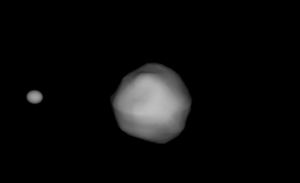
DART's target was Dimorphos, part of the 65803 Didymos system. This is a binary asteroid system. It means a smaller asteroid orbits a larger one. The main asteroid, Didymos A, is about 780 metres (2,560 ft) wide. Its moon, Dimorphos (Didymos B), is about 160 metres (520 ft) wide. It orbits about 1 kilometre (0.62 mi) from Didymos A.
The Didymos system weighs about 528 billion kg. Dimorphos makes up about 4.8 billion kg of that total. Choosing a binary asteroid system was smart. This is because changes to Dimorphos's speed can be seen easily. When Dimorphos passes in front of Didymos, the light from the system dips. Earth telescopes can spot this.
Dimorphos was also chosen because of its size. It's similar in size to asteroids we might want to deflect if they were heading for Earth. Also, the system was relatively close to Earth in 2022. It was about 7 million miles (0.075 astronomical units; 29 lunar distances; 11 million kilometers) away. The Didymos system is not an Earth-crossing asteroid. So, the experiment could not create a danger to Earth.
Getting Ready for Launch
Preparations for DART's launch started on October 20, 2021. The spacecraft began fueling at Vandenberg Space Force Base (VSFB) in California. DART arrived at Vandenberg in early October 2021.
The DART team checked the spacecraft's systems. They wrapped parts in special insulation. They also practiced the launch sequence. DART moved to the SpaceX Payload Processing Facility on October 26, 2021. Two days later, the team filled DART's fuel tank. It held about 50 kilograms (110 lb) of hydrazine for maneuvers. DART also carried about 60 kilograms (130 lb) of xenon for its ion engine.
On November 10, 2021, engineers attached DART to the adapter. This adapter sits on top of the SpaceX Falcon 9 rocket. The Falcon 9 rocket was tested. Then, technicians installed the two halves of the fairing around DART. This happened on November 16 and 17. The fairing protects the spacecraft during launch.
A day before launch, the rocket moved to the launch pad. It lifted off from Vandenberg Space Launch Complex 4 (SLC-4E). This began DART's journey to the Didymos system.
Launch Day
The DART spacecraft launched on November 24, 2021, at 06:21:02 UTC.
Earlier plans suggested DART would go into a high Earth orbit. From there, it would slowly use its ion engine to escape Earth's gravity. But DART launched on its own Falcon 9 rocket. So, the rocket's second stage put DART directly on a path to escape Earth. It went straight into orbit around the Sun.
This meant DART's electric thruster wasn't needed much. The Falcon 9 did most of the work. DART only had to make a few small adjustments to its path. It used simple chemical thrusters to home in on Dimorphos.
Traveling Through Space
The trip to Dimorphos took about 9 months. During its journey, DART flew past a near-Earth asteroid. This asteroid was called (138971) 2001 CB21. It was about 578-metre (1,896-foot) wide. DART passed 0.117 astronomical units (46 lunar distances; 17.5 million kilometres; 10.9 million miles) from it on March 2, 2022.
DART's DRACO camera took its first pictures on December 7, 2021. It was 2 million miles (0.022 astronomical units; 8.4 lunar distances; 3.2 million kilometres) from Earth. These pictures of stars helped calibrate the camera. On December 10, 2021, DRACO imaged the open cluster Messier 38. This was for more camera tests.
On May 27, 2022, DART observed the bright star Vega. This tested the camera's optics. On July 1 and August 2, 2022, DRACO watched Jupiter and its moon Europa. This was a test for the SMART Nav tracking system. It helped prepare for the Dimorphos impact.
The Impact Course
Two months before the crash, on July 27, 2022, DRACO spotted the Didymos system. It was about 32 million kilometres (0.21 astronomical units; 83 lunar distances; 20 million miles) away. This allowed DART to start fine-tuning its path.
The LICIACube nanosatellite was released on September 11, 2022. This was 15 days before the impact. Four hours before impact, DART started flying on its own. Its SMART Nav guidance system took over. Three hours before impact, DART checked for objects near its target.
Ninety minutes before the collision, DART was 38,000 kilometres (0.099 LD; 24,000 mi) from Dimorphos. The final path was set. When DART was 24,000 kilometres (0.062 LD; 15,000 mi) away, Dimorphos became visible to DRACO. The camera then sent real-time images of the asteroid's surface.
DRACO was the only tool that could show a detailed view of Dimorphos. DART's thrusters caused vibrations. This could blur images. To get clear pictures, the last path correction happened 4 minutes before impact. The thrusters were then turned off.
The last full image was sent two seconds before impact. It showed details as small as 3 centimeters per pixel. The impact happened on September 26, 2022, at 23:14 UTC.
The 500 kilograms (1,100 lb) DART spacecraft hit Dimorphos at 6.6 kilometres per second (4.1 mi/s). This impact likely released energy equal to about three tonnes of TNT. It was expected to slow Dimorphos's orbital speed by 1.75 cm/s to 2.54 cm/s. This slowdown would bring Dimorphos closer to Didymos. This would make its orbit shorter. A head-on impact makes it easier for telescopes on Earth to observe the change.
The impact transferred about 3.6 times more momentum than if DART had just been absorbed. This means the material blasted off (ejecta) helped move the asteroid more than the spacecraft itself. This shows we could use a smaller impactor or have less warning time to deflect an asteroid. Scientists estimate DART's impact blasted over 1,000,000 kilograms (2,200,000 lb) of dusty material into space. This is enough to fill six or seven train cars. The tail of ejecta from Dimorphos was at least 30,000 kilometres (0.078 LD; 19,000 mi) long.
The DART impact shortened Dimorphos's orbit by 33±1 minutes. Its orbit was previously 11 hours and 52 minutes. This big change shows the ejecta gave a significant push to the asteroid. The impact slowed Dimorphos's speed in its orbit by about 2.7 millimeters per second. This means the ejecta greatly increased the momentum change.
Even a small change in velocity can make a huge difference over time. For an asteroid threatening Earth, this tiny shift could prevent an impact if done early enough. Earth's diameter is about 13,000 kilometers. A shift of half that, 6,500 kilometers, could avoid a collision. A 2 cm/s velocity change adds up to that distance in about 10 years.
By crashing into it, DART made Dimorphos an active asteroid. Scientists had thought some active asteroids were caused by impacts. But no one had ever seen an asteroid become active before. The DART mission made Dimorphos active under known conditions. This allows scientists to study how active asteroids form for the first time. Observations show Dimorphos lost about 1 million kilograms of mass from the collision.
Impact Timeline
| Date (before impact) |
Distance from Dimorphos |
Raw image | Events |
|---|---|---|---|
| July 27, 2022 (60 days before) |
38 million kilometers (0.25 astronomical units; 99 lunar distances; 24 million miles) | The DRACO camera spots the Didymos system. | |
| September 11, 2022 23:14 UTC (15 days before) |
8 million kilometers (0.053 astronomical units; 21 lunar distances; 5.0 million miles) | LICIACube separates from DART. It then moves to avoid crashing into the asteroid. | |
| September 26, 2022 19:14 UTC (4 hours before) |
89,000 kilometers (0.23 lunar distances; 55,000 miles) | Final approach begins. SMART Nav starts guiding DART automatically. DRACO focuses on Didymos, as Dimorphos is still too small to see. | |
| 22:14 UTC (60 minutes before) |
22,000 kilometers (0.057 lunar distances; 14,000 miles) | The DRACO camera detects Dimorphos. | |
| 22:54 UTC (20 minutes before) |
7,500 kilometers (4,700 miles) | SMART Nav locks onto Dimorphos precisely. DART starts thrusting towards Dimorphos. | |
| 23:10 UTC (4 minutes before) |
1,500 kilometers (930 miles) | The final course correction begins. | |
| 23:11 UTC (2 minutes 30 seconds before) |
920 kilometers (570 miles) | Last image showing both Didymos (lower-left) and Dimorphos completely. | |
| 23:12 UTC (2 minutes before) |
740 kilometers (460 miles) | The final course correction ends. | |
| 23:14 UTC (20 seconds before) |
130 kilometers (81 miles) | The photos taken reach the expected clear resolution. | |
| 23:14 UTC (11 seconds before) |
68 kilometers (42 miles) | Last image showing all of Dimorphos by DART. | |
| 23:14 UTC (3 seconds before) |
18 kilometers (11 miles) | ||
| 23:14 UTC (2 seconds before) |
12 kilometers (7.5 miles) | Final complete image of Dimorphos sent. Resolution is about 3 cm per pixel. | |
| 23:14 UTC (1 second before) |
6 kilometers (3.7 miles) | Last partial image taken by DART before impact. The transmission stopped when the spacecraft was destroyed. | |
| 23:14 UTC (Impact) |
0 kilometers (0 miles) | DART hits Dimorphos (estimated speed 6 kilometers/second). | |
| 23:17 UTC (2 minutes 45 seconds after) |
56.7 kilometers (35.2 miles) | LICIACube's closest approach to Dimorphos. |
Images for kids
See also
 In Spanish: Double Asteroid Redirection Test para niños
In Spanish: Double Asteroid Redirection Test para niños
- Asteroid impact avoidance
- B612 Foundation
- Deep Impact (spacecraft)
- Don Quijote (spacecraft)
- NEO Surveyor
- The Spaceguard Foundation


